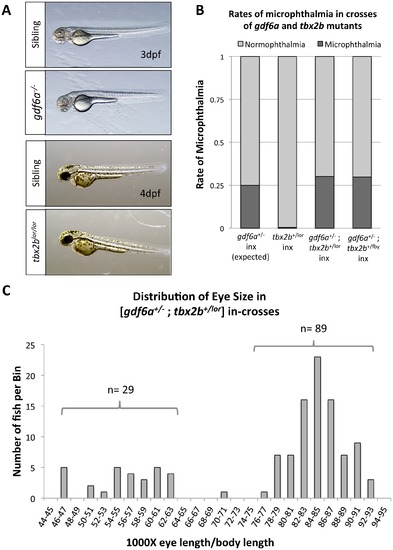Fig. 2
- ID
- ZDB-FIG-140716-25
- Publication
- Duval et al., 2014 - gdf6a is required for cone photoreceptor subtype differentiation and for the actions of tbx2b in determining rod versus cone photoreceptor fate
- Other Figures
- All Figure Page
- Back to All Figure Page
|
Disruption of tbx2b does not modify the gdf6a microphthalmic phenotype. A. gdf6as327/s327 mutants exhibit microphthalmia (observed at 3dpf) but tbx2b/ mutants (lor and fby) do not, indicating that disruption of tbx2b does not interfere with identical pathways as gdf6a in early eye development. B. Microphthalmia is rarely observed in tbx2b mutant in-crosses (inx) alone (tbx2b+/lor in-cross shown, n = 220) compared to in-crosses of gdf6a+/s327, which yield 25% with microphthalmia (following Mendelian ratios of inheritance and recessive phenotype). When [gdf6a+/s327;tbx2b+/lor] or [gdf6a+/s327;tbx2b+/fby] compound heterozygous mutants are in-crossed (n = 121 and 195 respectively, both at 6dpf), rates of microphthalmia do not increase significantly from rates expected of in-crosses of gdf6a+/s327 alone (X2 p = 0.873 and p = 0.137, respectively). C. The eye size compared to body length (shown as ratio) of a [gdf6a+/s327;tbx2b+/lor] in-cross does not reveal a subset of intermediate eye sizes, but remains bimodal, with the normophthalmic curve (right curve) showing a normal distribution (Shapiro-Wilk Normality test, W = 0.9888, p = 0.6532) (n = 118, 4dpf). |
| Fish: | |
|---|---|
| Observed In: | |
| Stage: | Protruding-mouth |

